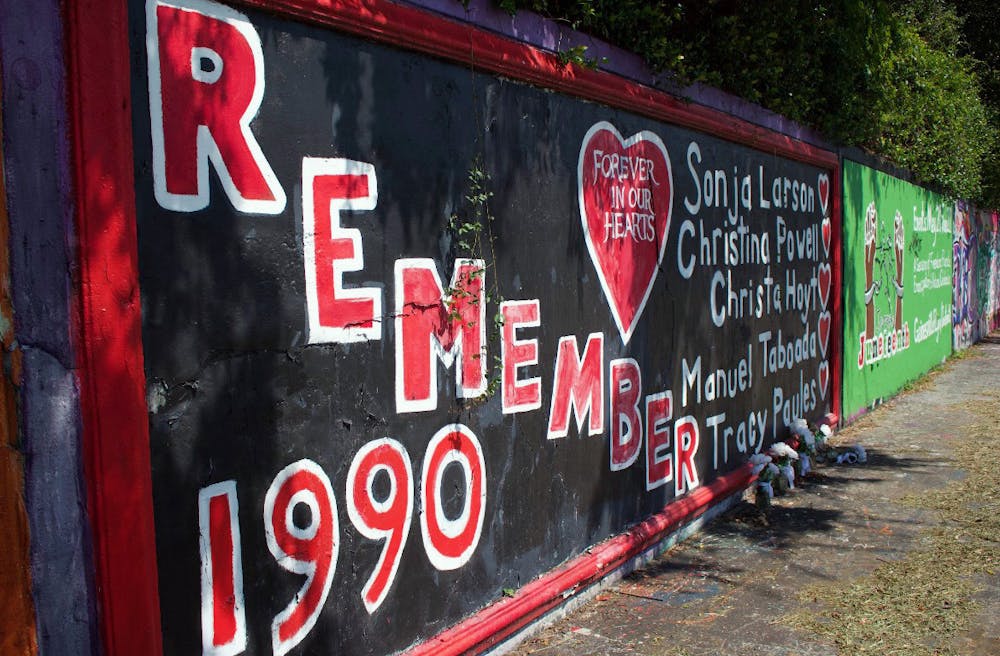Editor’s note: This story contains mentions of sexual assault and death and may be sensitive to some readers.
Retired Sheriff Sadie Darnell has a 45-year history with law enforcement. Now, she spends her mornings peacefully at home.
But 35 years ago, she was the public information officer for the Gainesville Police Department during a time of terror.
August 1990 was the beginning of another Fall semester at the University of Florida. For many college students, it ushered in another year of opportunity.
The community was horrified when five Gainesville college students were murdered within four days.
Sonja Larson was studying to become an educator. Christina Powell planned to become a crime scene investigator. Christa Hoyt was about to start school at Santa Fe College.
Tracy Paules was the newly elected president of Phi Alpha Delta Law Fraternity, an association for pre-law students. Manuel Taboada was about to enter UF’s architecture program.
Daniel “Danny” Rolling was identified as the killer in 1991 through DNA testing. At the time, he already occupied a cell in a Marion County jail due to a supermarket robbery.
Nationwide, Rolling is widely known as “The Gainesville Ripper.”
At the time, former Florida Gov. Bob Martinez deployed officers from multiple law enforcement branches, including state troopers and Florida Department of Law Enforcement agents, to campus.
As GPD’s PIO, Sadie Darnell was responsible for communicating with the families of the victims during the time of the murders.
“For that to happen in a medium-sized community or medium-sized police department [was] totally unexpected,” Darnell said. “We had to deal with it without any preparation and without any sense of having gone through it before.”
The incident sparked a strong sense of community, she said, because people made an extra effort to keep each other safe by walking friends to their cars and turning on the lights outside their homes at night.
Darnell said she feared talking to the victim’s families for the first time.
“Think of them as your neighbor, because they are,” Darnell said. “Any of us could be a survivor of murder or victim, and so we need to recognize that it’s not an isolated thing that only happens to other people.”
She commended former UF President John Lombardi for continuing classes and football games after the murders occurred.
“It was a brilliant thing to do because it started the healing process of our community,” Darnell said.“It was a start, a return to normalcy, a different normalcy.”
Murder crimes continue to impact “too many families in horrific ways,” she said.
Four University of Idaho students were murdered in an off-campus home in November 2022. Bryan Kohberger was given life in prison for the murders July 23. He declined to explain his motive when asked.
Blue light emergency phone poles can be seen on college campuses across the nation to deter crime. The blue emergency phones immediately connect a caller to emergency services in a direct line.
UF’s Blue Light Emergency Phones call the University Police Department. They are available 24/7.
The phones are the result of the parents of Jeanne Clery, who lobbied on college campuses after their daughter, a student at Leigh University, was raped and murdered in her on-campus dorm.
The 1990 Jeanne Clery Safety Act requires college and university campuses, which participate in federal financial programs, to log all crimes reported to the institution, publicly report campus crime data and give timely warnings about crimes threatening their students and faculty.
In 2021, degree-granting postsecondary institutions, universities like UF and Florida State University, reported around 23,400 on-campus criminal incidents. Of reported on-campus crimes, 44% were forcible sexual offenses, and 9% were aggravated assaults.
In 2023, UF stated there were 352 reported crimes. Of the reported on-campus crimes, 4.5% were rape, and 31.25% were domestic violence.
Nicki Spirtos, a Stetson University College of Law 1994 graduate, was deciding where to attend law school when the murders occurred. The UF murders affected her decision, she said.
Spirtos had been accepted to both UF and Stetson University. At the time, she attended Stetson University for her undergraduate studies.
Spirtos said she was “terrified” by how similar her lifestyle was to the victims.
“There was a rumor that this killer was on his way to Volusia County, though how would anybody know that?” Spirtos said. “I was living in Volusia County in an apartment by myself, and that was a very frightening time.”
Jan Gordon, a 63-year-old Gainesville resident, lived in Gainesville while the murders occurred. The days following the murder were a “fearful time” because of the mystery of who was behind them, she said.
People felt they had to take extra security precautions, she said, such as keeping doors locked and checking front doors before letting anyone inside. Gordon’s family had a friend stay with her at the time.
The 1970s and 1980s had a significant number of serial killers compared to other decades. The number has declined since. The '70s saw 286 serial killers, and there were 259 serial killers in the ‘80s, by decade of first killing. In the 2010s, there were 42 serial killers.
Instead of serial killers, it is more common for college campuses to be struck by gunfire.
There were 229 incidents of gunfire on school grounds in 2024. There have been 74 school shootings in 2025 as of July 27.
Florida State University experienced a shooting in April. The alleged gunman, a 20-year-old FSU student and son of a Leon County deputy, killed two and injured six in open fire in the university’s student union.
Gordon said people can find comfort in tragic times through religion.
“My son is a pastor now at Tallahassee, and the shootings up there, he said, it’s a lot like that feeling of people are just scared,” Gordon said.
In remembrance of the tragedy, a memorial was constructed on Southwest 34th Street in Gainesville in 1990.
Five palm trees, planted in 2000, line the street, swaying in the breeze. Each of the palms has a plaque representing one of the victims.
Nearby, a painted mural on the 34th Street Wall urges people not to forget the incident. The wall, painted black with red hearts over it, contains the names of the five victims painted in white.
“Remember 1990,” it reads.
Contact Alanna Robbert at arobbert@alligator.org. Follow her on X @alannafitzr.

Alanna is a journalism senior and the Fall 2025 data reporter for The Alligator's Enterprise desk. She was previously a general assignment reporter for metro. Outside of reporting, she is found either with a book, in the gym or with friends playing pool.






